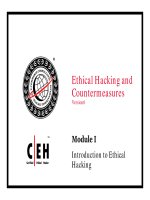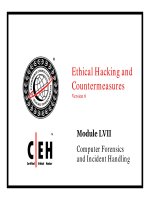Ethical hacking and countermeasures - phần 30 ppsx
Bạn đang xem bản rút gọn của tài liệu. Xem và tải ngay bản đầy đủ của tài liệu tại đây (2.03 MB, 120 trang )
Ethical Hacking
Exploit Writing
EC-Council
Copyright © by EC-Council
All Rights reserved. Reproduction is strictly prohibited
Module Objective
What are exploits?
Prerequisites for exploit writing
Purpose of exploit writing
Types of exploit writing
What are Proof-of-Concept and Commercial grade exploits?
Attack methodologies
Tools for exploit write
Steps for writing an exploit
What are the shellcodes
Types of shellcodes
How to write a shellcode?
Tools that help in shellcode development
EC-Council
Copyright © by EC-Council
All Rights reserved. Reproduction is strictly prohibited
Module Flow
Exploits Overview
Tools for Exploit Attack Methodologies
Steps for
Exploit Writing
Shellcodes
Steps for
Shellcode Writing
Types of Exploit
Purpose of
Exploit Writing
Prerequisites
Issues Involve
In Shellcode Writing
Steps for
Shellcode Writing
EC-Council
Copyright © by EC-Council
All Rights reserved. Reproduction is strictly prohibited
Exploits Overview
Exploit is a piece of software
code written to exploit bugs
of an application
Exploits consists of shellcode
and a piece of code to insert it
in to vulnerable application
EC-Council
Copyright © by EC-Council
All Rights reserved. Reproduction is strictly prohibited
Prerequisites for Writing Exploits and
Shellcodes
Understanding of programming concepts e.g. C programming
Understanding of assembly language basics:
• mnemonics
• opcodes
In-depth knowledge of memory management and addressing
systems
• Stacks
• Heap
• Buffer
• Reference and pointers
• registers
EC-Council
Copyright © by EC-Council
All Rights reserved. Reproduction is strictly prohibited
Purpose of Exploit Writing
To test the application for existence
of any vulnerability or bug
To check if the bug is exploitable or
not
Attackers use exploits to take
advantage of vulnerabilities
EC-Council
Copyright © by EC-Council
All Rights reserved. Reproduction is strictly prohibited
Types of Exploits: Stack Overflow
Exploits
A stack overflow
attack occurs
when an oversized
data is written in
stack buffer of a
processor
The overflowing
data may
overwrite program
flow data or other
variables
Variable X
Variable Y
Return
Address in
main
Parameter a
Reference
Parameter b
Local
Variable C
Local
Variable
Buffer
Main
Process
Variable X
Variable Y
New Return
Address
etc…
Code to set
up back
door
…Overflow
NO-OP
Hacker Data
NO-OP
Main
Process
EC-Council
Copyright © by EC-Council
All Rights reserved. Reproduction is strictly prohibited
Types of Exploits: Heap Corruption
Exploit
Heap corruption occurs
when heap memory area
do not have the enough
space for the data being
written over it
Heap memory is
dynamically used by the
application at run time
Heap
Data
String
Data
Next Memory
Pointer
Points to This
Address
EC-Council
Copyright © by EC-Council
All Rights reserved. Reproduction is strictly prohibited
Types of Exploits: Format String
Attack
This occur when users
give an invalid input to a
format string parameter
in C language function
such as printf()
Type-unsafe argument
passing convention of C
language gives rise to
format string bugs
EC-Council
Copyright © by EC-Council
All Rights reserved. Reproduction is strictly prohibited
Types of Exploits: Integer Bug Exploits
Integer bugs are
exploited by passing an
oversized integer to a
integer variable
It may cause
overwriting of valid
program control data
resulting in execution
of malicious codes
EC-Council
Copyright © by EC-Council
All Rights reserved. Reproduction is strictly prohibited
Types of Exploits: Race Condition
Race condition is a software vulnerability
that occurs when multiple accesses to the
shared resource is not controlled properly
Types of Race Condition Attacks
• File Race Condition
– Occurs when attacker exploits a timed non-
atomic condition by creating, writing,
reading and deleting a file etc in temporary
directory
• Signal Race Condition
– Occurs when changes of two or more signals
influence the output, at almost the same
instant
EC-Council
Copyright © by EC-Council
All Rights reserved. Reproduction is strictly prohibited
Types of Exploits: TCP/IP Attack
Exploits trust relationship between systems by spoofing TCP
connection
TCP Spoofing
• Attacker system, claiming as legitimate, sends spoofed SYN packets
to the target system
• In reply target system sends SYN + ACK packets to the spoofed
address sent by attacker’s system
• Attacker begins DoS attack on the target system and restricts it from
sending RST packets
• Spoof TCP packets from target to spoofed system
• Continue to spoof packets from both sources until the goal is
accomplished
EC-Council
Copyright © by EC-Council
All Rights reserved. Reproduction is strictly prohibited
The Proof-of-Concept and Commercial
Grade Exploit
Proof-of-Concept Exploit:
• Explicitly discussed and reliable method of testing a system for
vulnerability
• It is used to:
– Recognize the source of the problem
– Recommend a workaround
– Recommend a solution before the release of vendor-released path
Commercial Grade Exploit:
• A reliable, portable and real time attack exploits are known as
commercial grade exploit
• Features:
– Code reuse
– Platform independency
– Modularization
– Encapsulation
EC-Council
Copyright © by EC-Council
All Rights reserved. Reproduction is strictly prohibited
Converting a Proof of Concept Exploit to
Commercial Grade Exploit
Brute forcing
Local exploits
OS/Application fingerprinting
Information leaks
Smaller strings
Multi-platform testing
EC-Council
Copyright © by EC-Council
All Rights reserved. Reproduction is strictly prohibited
Attack Methodologies
Remote Exploit
• Remote exploits are used to exploit server bugs where user do not have
legitimate access to server
• remote exploits are generally used to exploit services that do not run as
root or SYSTEM
• Remote exploits are carried out over a network
Local Exploit
• local exploits exploit bugs of local application such as system
management utility etc
• Local exploits are used to escalate user privileges
Two Stage Exploit
• Strategy of combined remote and local exploit for higher success is
known as two stage exploit
EC-Council
Copyright © by EC-Council
All Rights reserved. Reproduction is strictly prohibited
Socket Binding Exploits
Involves vulnerability of sockets for exploitation
• Client Side Socket Programming:
– Involves writing the code for connecting the application to a remote
server
– Functions used are:
– int socket(int domain, int type, int protocol)
– int connect(int sockfd, const struct sockaddr *serv_addr, socklen_t addrlen)
• Server Side Socket Programming:
– Involves writing the code for listening on a port and processing incoming
connections
– Functions used are:
– int bind(int sockfd, struct sockaddr *my_addr, socklen_t addrlen)
– int listen(int sockfd, int backlog)
– int accept(int s, struct sockaddr *addr, socklen_t *addrlen)
EC-Council
Copyright © by EC-Council
All Rights reserved. Reproduction is strictly prohibited
Tools for Exploit Writing
LibExploit
Metasploit
CANVAS
EC-Council
Copyright © by EC-Council
All Rights reserved. Reproduction is strictly prohibited
Tools for Exploit Writing : LibExploit
Generic exploit creation tool
Features:
• Common Network functions
• Common Buffer Overflow functions
• Choose between many shellcodes for different O.S.
and platforms
• Encrypt shellcodes to evade NIDS
• Get the remote or local O.S. and put the correct
shellcode
• Multiplatform exploits
• Smart, better and easier exploits
EC-Council
Copyright © by EC-Council
All Rights reserved. Reproduction is strictly prohibited
Tools for Exploit Writing: Metasploit
It is an open-source platform for writing, testing, and using exploit code
Metasploit allows sending of different attack payloads depending on the
specific exploits run
It is written in Perl and runs on Windows, Linux, BSD and OS X
Features:
• Clean efficient code and rapid plug-in development
• Improved handler and callback support that can shorten the exploit code
• Supports various networking options and protocols to develop protocol dependent
code
• Includes tools and libraries to support the features like debugging, encoding,
logging, timeouts and SSL
• A comprehensible, intuitive, modular and extensible exploit API environment
• Presence of supplementary exploits to help in testing of exploitation techniques and
sample exploits produced
EC-Council
Copyright © by EC-Council
All Rights reserved. Reproduction is strictly prohibited
Metasploit
EC-Council
Copyright © by EC-Council
All Rights reserved. Reproduction is strictly prohibited
CANVAS
CANVAS is a security tool written in Python and developed by Immunity
Software’s team
It is an inclusive exploitation framework that casts vulnerability information into
practical exploits
Components of CANVAS:
• CANVAS Overview:
– Contains the explanations of CANVAS design with GUI layout and interaction
• LSASS Exploit:
– Shows CANVAS exploit for lsass.exe
• SPOOLER Exploit:
– Shows CANVAS exploit for spooler.exe
• Linksys apply.cgi Exploit:
– Shows
exploit for the apply.cgi overflow influencing various linksys devices
• MSDTC Exploit:
– Shows CANVAS msdtc exploit
• Snort BackOrifice Exploit:
– Shows CANVAS exploit for the Snort Back Orifice Preprocessor vulnerability
EC-Council
Copyright © by EC-Council
All Rights reserved. Reproduction is strictly prohibited
CANVAS (contd)
CANVAS runs on Windows 2000, XP and Linux; and operate on both GUI and
command line
Features:
• Working syscall proxy system
• Solid payload encoder system
• Automatic SQL injection module
Working of CANVAS on GUI:
• Setting the target:
– Set the vulnerable host for attack
• Selecting and running the exploit:
– Select the planned attack and run the exploit
• Handling an effectively hacked host:
– Communicate with hacked host by running the commands
• Setting the host for further attacks:
– Bounce the attack in further nodes
• Striding the attack outside the framework:
– Set the attack outside the predefined framework
EC-Council
Copyright © by EC-Council
All Rights reserved. Reproduction is strictly prohibited
CANVAS
EC-Council
Copyright © by EC-Council
All Rights reserved. Reproduction is strictly prohibited
CANVAS
EC-Council
Copyright © by EC-Council
All Rights reserved. Reproduction is strictly prohibited
Steps for Writing an Exploit
Identify and analyze application bug
Write code to control the target memory
Redirect the execution flow
Inject the shellcode
Encrypt the communication to avoid IDS
alarms









